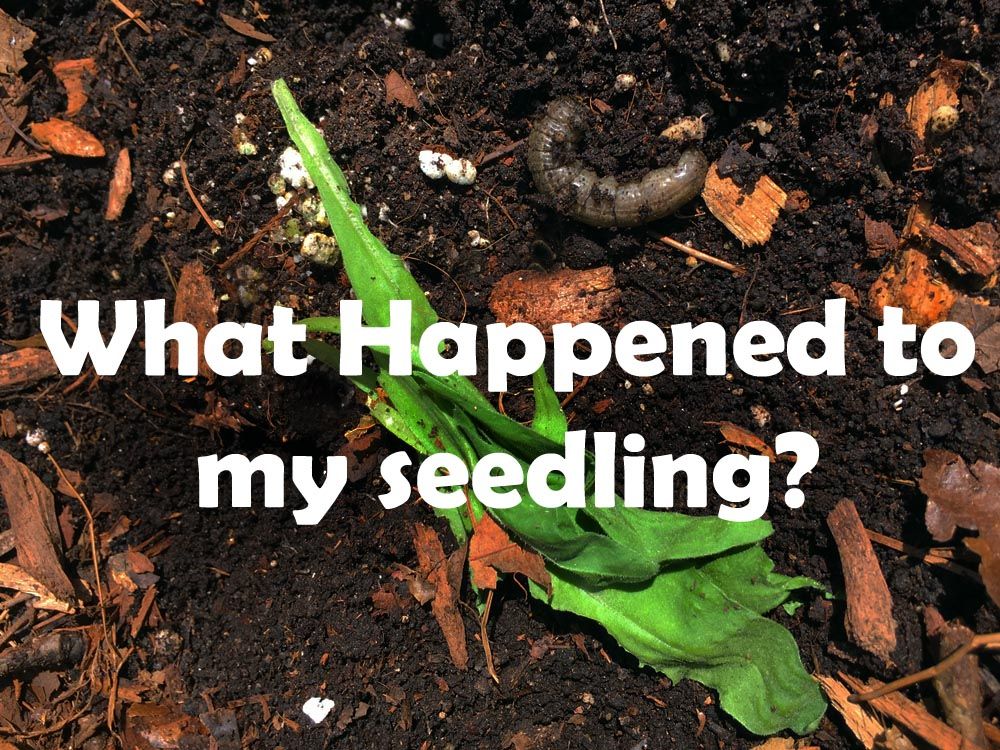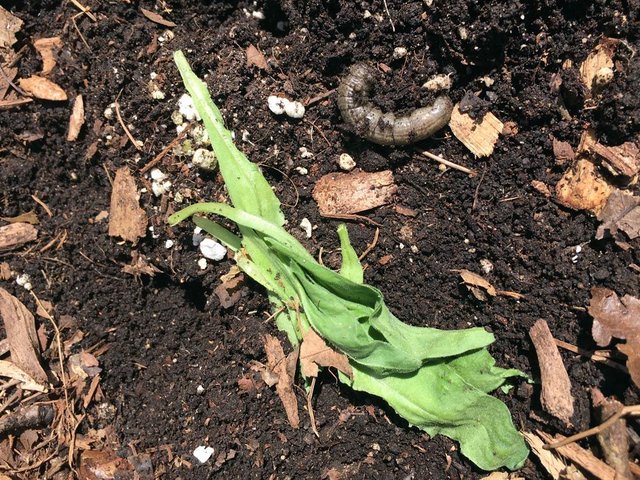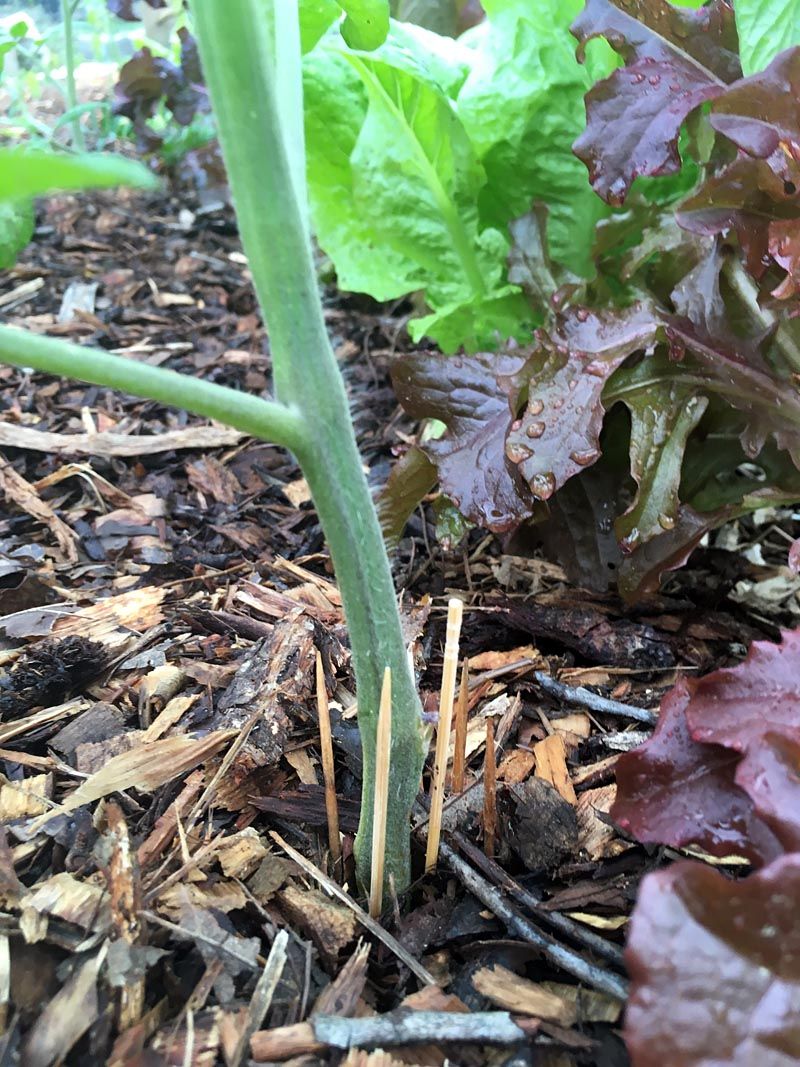What Keeps Cutting My Seedlings Down !?


Damn! What happened to my calendula seedling!?
Well, don’t you just love cutworms. After taking care of my calendula seedling for four weeks indoors, watering it once a day, checking for pests, and carefully selecting & planting it in the perfect spot, seeing it laying on the ground the next morning made my blood boil. So I moved away the mulch, dug down about 2 inches deep and found this fat bastard. I yelled at it for a few seconds then I cut it into three pieces ensuring its death and laid its cut up body parts out for all other cutworms to see. Don’t mess with my garden, don't mess with my seedlings or you will be sorry!
I wouldn't say I am a super experienced gardener. My husband built our first raised bed only 6 years ago and before that I had no experience with growing food. I practice the no till, organic, permaculture way of gardening. Growing your own food without pesticides can be tricky enough without mother nature constantly throwing curve balls at you. I have always had issues with cutworms in my garden. I have tried the toilet paper rolls and the plastic cups techniques, but it was just so much extra work and I did not like using so many plastic cups. While doing searches for cutworm prevention, I read that to fully girdle or cut a seedling, the cutworm must have access to the entire circumference of the seedling’s stem. Based on that, my husband suggested trying toothpicks. I inserted five toothpicks or less vertically around each seedling, keeping the toothpicks tightly against the stems of the seedlings and spacing them at an equal distance (see picture below). The toothpicks keep the cutworm away from the stem. What a simple way to deter cutworms and prevent damage to seedlings. This has been my preferred method for a few years now and has worked perfectly ... if I can only remember to place toothpicks around the stems on all the seedlings. This year, I also started to use the longer 4" toothpicks, which can also be described as skewers. These longer toothpicks give me the assurance the seedlings will be protected even deeper into the soil. Cutworms live and explore under the surface. The longer toothpicks really let the destructive worms know they WILL NOT be chopping down anything from my food forest.

Those little cutworms can devour so much for their size! I have a small scale heirloom tomato farm and battle them usually late in our season here (zone 7).
Toothpicks do work pretty well, but they can also be confused by sticks! I take sticks and plug them into the soil around the plants to confuse them. They will crawl up a stick and realize there's no food. After they do that a few times they tend to find their way out of the garden.
Crunching up some egg shells and sprinkling around the base of plants being attacked can also deter them. They tend to dislike scratchy surfaces and I see you use mulch - that also works pretty nicely.
Another little secret from some local farmers here: learn about soil testing and BRIX levels in plants. High BRIX ( basically sugars/carbs ) in plants really helps deter pests of all kinds. I have found that pests prefer weak plants - they are easy targets. Plants with high brix levels are usually the last plants to get eaten.
I grew a little more than a hundred tomato plants last year and experimented with several different beds and soils. I found plants with thick stem/herd were attacked less often and in many cases not at all.
I plant decoys - sunflowers! They attract everything..lol Like the pest community center, it gives them all a place to gather. Then I release the mantis and they get to work! I swear by ladybugs and praying mantis - they two most underpaid garden helpers 😋
You seem to have preventative measures in place, so keep up that good fight! Happy growing, Happy Harvest!
Thanks for sharing your experience! I am also in zone 7. You gave me a lot of different options to think about. How do you test BRIX level in plants in a backyard garden? I always do a happy dance when I see a lot of ladybugs and praying mantis. They are definitely hardworking garden helpers!
My pleasure! Gardening is a constant learning process, so experimenting is what I love most about it. Testing brix levels can be tricky and costly if you get the proper tools. You'll need a refractometer to actually test the levels, however, there are some ways to enhance your soil that will not require expensive tools.
One thing to note is testing soil can give you some idea of what nutrients are deficient and which are excessive. Too much nitrogen can cause many issues that make plants vulnerable to pests. N-P-K are the three main ones to test for. If you have too much nitrogen/nitrates then try to increase the potassium levels.
It can be overwhelming, I know. Start small and build up. There's so much reading and experimenting that you'll never get bored in the garden again..lol
Here are some articles I bookmarked that really helped me start to understand all this:
• http://npk-industries.com/resources_BULDING_up_the_Brix.html
• https://www.highbrixgardens.com/victory-gardens/the-path-to-high-brix.html
• https://www.maximumyield.com/building-up-the-brix-for-healthier-nutrient-dense-crops/2/1282
These were three articles that really piqued my interest and I tried several techniques last year. I was really astonished at the results I was able to accomplish. The prior year I had pest issues and my highest yield on a single indeterminate tomato plant was 22lbs or so. Last year I was able to pull 53 lb of tomatoes from a single indeterminate tomato plant. Less pest damage and nearly doubled my max yield per plant by experimenting. At this time last year I already 6wk old plants outside, but this year the weather has not been as cooperative 😆
Momma Nature is the Boss, we are just the garden accountants and labor force 😋
Wow, thank you so much for taking the time to write! You gave me so much great info. I will be spending some time reading. 53 lbs of tomatoes from one single indeterminate tomato plant is absolutely amazing! I still have a lot to learn for sure.
Very good idea! We have been taught to think first about chemicals or "go buy" this or that. You did a great job of putting your thinking cap on and coming up with a simple, non-toxic solution!
Thank you so much for your kind words! My husband was the one who came up with the toothpick idea, so I can't take credit. All I did was cried and told him there was no way I could continue to garden organically because cutworm cut everything, lol. I sure am glad we did not give up gardening and growing our own food.
Well it sounds like you've got a keeper then. lol
I would try Diatomaceous Earth. DE works great against soft-bodied insects.
Thank you for your suggestion! I tried DE one year, but we have a lot of Spring rains and having to go out and dust with DE every couple of days was more work than I wanted. I am just too lazy of a gardener I guess. I am following you now. You have so much really great info on your blog. Looking forward to learning from you.
I feel your pain. This is the first year I've planted into sheet mulch beds and so far my broccoli and bak choi have both been eaten. The marigolds I planted around them (which are supposed to deter the pest or provide alternative food for them) were munched away just after. So back to the seedling stage I go. I don't know much about cutworms but I found this on the net for you: https://organicgardeningnewsandinfo.wordpress.com/2013/10/15/organic-control-of-cutworms/
Hope it helps! I'm now following you. Good luck with you growing, can't wait to se your progress.
PS: If you have any tips for me with my broccoli and bak choi I'd be grateful. :-). One love x
Thank you for posting the article and thank you for following me. I am new to Steemit, so I am glad to find people with similar interests for me to read and learn from. I am learning about permaculture and loved reading your permaculture post. Also truly enjoy the wild food posts of yours. Keep them coming. I am learning so much!
You're welcome. Thank you for taking the time to read my articles also. Permaculture really needs to be taught in schools. I've been on here since last year but took a break from posting for quite a few months. I feel like a newbie also haha. Lovely to meet you here on Steem and look forward to seeing more of your posts! :-) - One love
We have a lot of success controlling insects with neem oil. It is organic and non toxic.
I also use neem oil for pest control when things get out of hand. I did not know neem oil can deter cutworm.
I only have a few things I protect from cutworms: tomatoes and peppers. I start the calendula inside and it's good size by the time I plant it. The cutworms have never bothered it. Come to think of it, they've never bothered the dozens of volunteers that come up in the garden each year.
One thing that makes plants attractive to pests is too high nitrogen in the soil. You do need some, but too much weakens plants and the pests attack. Another reason could be your soil is too un-balanced and that will weaken plants also.
I've found balancing the soil to be the very best thing I've done for pests and disease control. Each year there's less and less as my soil works its way to being in balance.
I am a firm proponent to fixing the problem, not applying a bandaid to it.
I started my calendula inside as well. The cutworms I have don't seem to care at all what plants they are. They cut tomatoes, peppers, flowers... I have heard of milky spores keeping grubs and cutworms away but have not tried it myself.
I have used toothpicks in the past with great results. I am thinking about soaking some toothpicks in peppermint oil and sticking them around the bases of some plants this year.
That's a great idea! Might do that to other plants I have not planted yet.
I was gifted some Calendula seed so this is the first year growing. Thankful for the tips. I get so frustrated with the deer I could go nuts! Happy Gardening!
I live in an area with lots of deer as well. It seems most things accidentally growing outside of the fence is eaten by them. I am always looking for ways to deter them. Also looking for plants that they won't eat. The deer in our area will eat everything that's labeled "deer resistant", lol. Happy gardening. Looking forward to seeing the inside of your beautiful greenhouse!
Thank you for sharing your knowledge! This post has been added to our growing directory of Steemit "how to" posts for the Homesteading/Survival/Foraging/Prepper communities. Your post is helping people learn to survive and thrive now and in the future!
Can I ask what cutworms are?? Our earwigs eat young seedlings at certain times of the year - coffee grains seem to deter them.
You see the second picture from the top? Look at the top center part of the photo, you will see a cutworm. Cutworms are caterpillars. They chew through plant stems at the base and killing them.
I missed it sorry! Horrible critters. That's exactly what earwigs do. How frustrating for you!